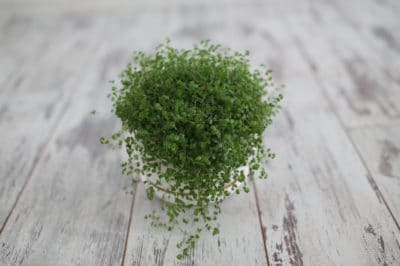Best Growing Conditions
Baby tears will grow in any light situation, although it may be a little more leggy in deep shade than full sun. The plant does well in a variety of soils: it prefers a slightly acidic to neutral pH. It does require a constantly moist soil and will not do well in drought conditions. It will produce more of its tiny white flowers in full sun.
Where to Grow Baby Tears
A Mediterranean plant, baby tears can be grown as an outside ground cover in USDA Zones 9 and above. If frosted, it may blacken and die back to the roots, but will quickly recover once the weather warms. It cannot tolerate foot traffic. In warmer areas, it may do better in dappled shade than full sun.
Baby Tears Varieties
Current options for baby tears include:
- Soleirolia soleirolii – standard variety, shiny lime green leaves.
- Soleirolia soleirolii ‘Aurea’ – this plant grows a little lower than the species and does not spread as widely. The leaves are yellowish green. It does better in dappled shade.
- Soleirolia soleirolii ‘Variegata’ – also known as Argentea or Silver Queen. The foliage is silver green to silver gray.
Propagating Baby Tears
This herbaceous perennial roots readily from pieces of stem. Although it may produce seeds, there are no commercial sources. In most cases, gardeners who want to plant baby tears buy a flat of starts from a nursery, divide some they have grown or obtain divisions from a friend or neighbor. In the right conditions, the plant will spread rapidly.
Consider Barriers
Since baby tears can be invasive, you should consider whether you need a way to keep it contained. If you are planting in something like a strip between the sidewalk and the street, it’s not likely to be a problem. However, baby tears grown as a ground cover next to a lawn can spread, unless the foot traffic is high enough to keep it down.
Planting Baby Tears
The small strands of baby tears may look delicate, but they root readily in moist soil. Tease out individual stems with some roots attached. Place the roots in the prepared hole and dribble a little soil over them. Press the soil down gently and water in well. Spacing depends on how fast you want to cover the ground; you can space as closely as four inches apart.
